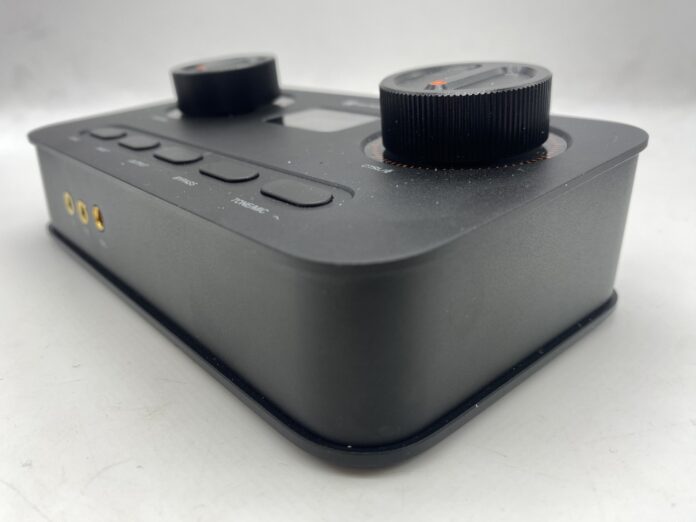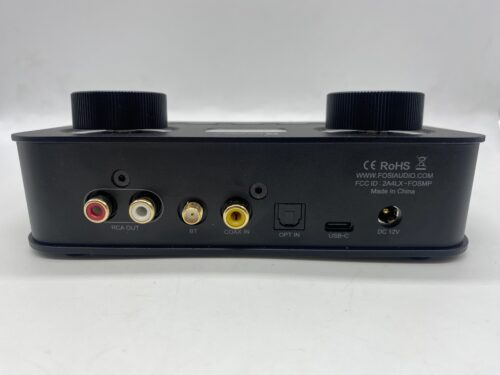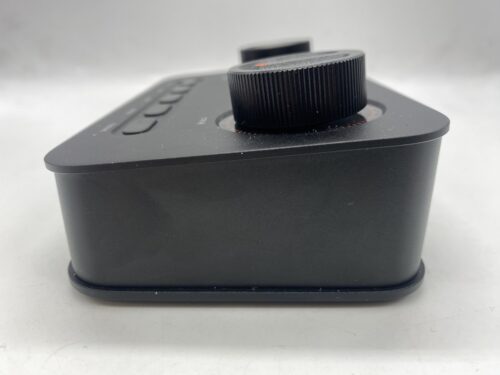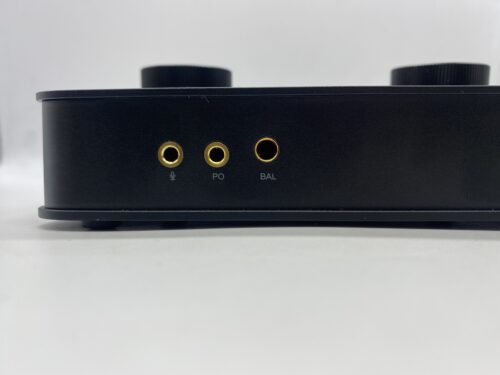During CanJam NYC 2025, I checked out Fosi Audio. At their table, I listened to one of their headphones, as well as their own DAC/Amp. This device is the K7, which, as of writing this review, has been successfully backed on Kickstarter. After the show, I was able to get my hands on one for myself to review. I had no idea this was also a gaming product, as I was exclusively listening to higher-end audiophile headphones with it. It has the look of a traditional gaming mix amp, but seems to be geared more toward audiophile-minded gamers. Can it live up to those claims? Let’s examine the Fosi K7’s design, functionality, and sound performance to see if it’s the right fit for your audio setup.
What You Get
- Fosi Audio K7
- USB-A/C to USB-C Cable
- Bluetooth Antenna
- DC 12v Power Supply
- 3.5mm headphone Splitter
- User Manual
Build
While the Fosi K7 markets itself as a HiFi desktop DAC/Amp, the unit itself doesn’t take up too much real estate. It’s a compact and ergonomically constructed device that looks good on any desktop surface. The sleek angled design pronounces the volume knobs and button rows for easier access if you set the K7 on a short shelf and you want to make quick adjustments. If there was any part of the build I could criticize, it’s that the volume knobs feel a bit too loose. They also act as buttons you can click in, but it stands out when the K7 is weighted in a way that makes it hold steady on any surface. Otherwise, the Fosi K7 has a great design for an affordable DAC/Amp.
Fosi Audio has found a way to supply tons of different connection options for as small of a device as the K7 is. You get two 3.5mm plugs for both a mix and a headphone, and a 4.4mm balanced output to support more audiophile headphones. On the back, the K7 provides RCA out for speaker connection, and optical/coax input for TV or streamer connection. This DAC/Amp also supports Bluetooth, and the K7 has a place on the back to screw in its Bluetooth antenna.
Design & Functionality
Inside the Fosi K7 is a few different chipsets, with one including an AKM 4493SEQ which is very rare. It also contains XMOS XU208, and QCC 3031 chipsets, combined with headphone protection circuits. Low-noise LDO regulators are implemented for better signal flow. The K7 can reach some high sample rates, with the specs stating that it can unfold 384kHz-32bit/DSD256 through USB. With the LED screen, the K7 will show you the current sample rate you are listening in, which is very accurate based on what your source says. I was able to listen to a few hi-res tracks at 192kHz without any hassle through the K7.
Bluetooth
As a Bluetooth DAC/Amp, the K7 isn’t the most advanced, only supporting version 5.0. However, it is still very capable, especially when listening through the aptX LL CODEC.
Sound Impressions
I tested a few different headphones with the K7. Using a trusty pair of Sennheiser HD 800s and a pair of HD 650s, I got a good idea of what the amplifier could handle. I was pleasantly surprised by what the K7 could do in terms of running high-impedance headphones. Both headphones were used with the provided 4.4mm balanced headphone out, and I specifically used the Strauss & Wagner Hagen cable attached to the HD 650, which I feel gave me the best sound I’ve heard from them in a while. It’s hard to make the HD 800s sound bad, but the amount of headroom provided by the K7 gave it so much room to breathe in. Even on low gain, these high impedance headphones run very sufficiently, with ample space and even levels of gain throughout the sound signature.
Soundstage
With the K7 being partially a gaming peripheral, I was excited to hear how it could enhance the bass and soundstage of my headphones. I kept using the HD 800s and HD 650, but also threw in a HiFiMAN HE1000 Unveiled and Dan Clark Noire X. What the K7 seems to do best is stack sound layers evenly, giving height and depth to each headphone you’re running. This benefits games and music well, making sure separation and positioning are true. It leaves room for sound effects, music, and dialogue to play together without congealing.
That extra level of clarity in the soundstage makes a huge difference in discerning what is playing where, which can make or break your immersion within a game. Headphones like the HE1000 Unveiled and HD 650 felt like they were having their sound propelled outward, as the K7 does a lot to elevate the headspace of those headphones.
However, the K7 doesn’t do much to extend width. This was prevalent listening to the HD 800s and Noire X. The 800s is usually very wide, and although the K7 didn’t retract anything from its natural soundstage performance, something was sacrificed for more holographic stereo imaging. You get a similar effect with the Noire X, which is obviously closed-back, but still puts on much stronger barriers in the left and right channels. I don’t think this takes away anything when listening to music and game audio though, especially with how well the K7 weaves through the stereo field. I’ve never heard a gaming amp that adds this much breathability with high-end headphones, and that’s an impressive feat.
Bass
As for the bass response, the K7 uses a bypass mode that acts as a bass boost. Testing out the K7 with my selection of headphones revealed what part of the bass was actually being boosted. Each headphone was given a slight lift in sub-bass gain that layered nicely underneath their respective sound signatures. I found this to be a nice novelty, rather than being a true elevation of the bass frequencies, but it did lend a helping hand to a headphone like the HD 800s that might need it. Otherwise, I tended to leave the bass bypassed to achieve a more natural bass performance. This is where the Fosi K7 shows its more dynamic bass properties, even if it doesn’t add much in the way of impact. The K7 can be a bit soft on mid-bass transients, but the detail is there, and individual notes are easy to discern.
Mids
The thing I took away most from the mids and treble is just how weightless and airy the Fosi K7 makes everything sound. On some headphones like the HD 800s and Noire X, the K7 was not able to carry the level of strike and specificity that I’m used to hearing with those headphones, but it provided even more spaciousness to headphones like the HD 650 and HE1000 Unveiled. The K7 provided good clarity in the mids, and even stabilized some of the low-mid fog in the HD 650, but if you’re looking to hear notes with some edge, then the K7 might not accommodate that to your headphones. I think for gaming this sound signature works, but for some music genres it may feel lacking.
Highs
As for the highs, the Fosi K7 keeps everything well defined. The highs appear with natural detail whilst not shying away from brightness. It never gets harsh, but some form of sibilance could be heard when I was listening to the HE1000 Unveiled, and the HD 600. Like the soundstage would infer, the treble gains a lot of height, and its crispness is propelled outward into the open air with some headphones. Even the closed-back Noire X reached this effect.
Summary
The Fosi Audio K7 proves to be a formidable entry in the budget DAC/Amp market, offering a well-balanced mix of power, clarity, and connectivity. Its compact design, high-resolution playback, and balanced headphone output make it a strong contender for those looking to elevate their audio experience without overspending. While it may not deliver the widest soundstage or the most aggressive bass boost, the K7 excels in providing a clean, immersive listening experience, particularly for gaming and high-impedance headphones. If you’re in search of an affordable yet capable DAC/Amp with solid performance, the Fosi K7 is a worthy addition to your desktop setup.
| Pros | Cons |
|
|
The Fosi Audio K7 is available here.
MAJORHIFI may receive commissions from retail offers.











